HRM Report: Stakeholder Engagement and HRM Practices Analysis
VerifiedAdded on 2022/01/06
|14
|3758
|448
Report
AI Summary
This report delves into the critical role of stakeholder engagement in Human Resource Management (HRM). It highlights how various stakeholders, including management, trade unions, and government agencies, influence employee relations and shape HRM practices. The report examines the functions and aims of each stakeholder, detailing their impact on recruitment, training, wages, and overall employee well-being. It emphasizes the significance of considering stakeholder expectations to effectively manage employees and maintain a healthy work environment. The analysis covers the impact of state regulations, trade union actions, management strategies, and employer associations on HRM, offering insights into conflict resolution, cost management, and the promotion of a productive and harmonious workplace. The report underscores the importance of adapting HRM practices to align with stakeholder needs and maintain a positive employment relationship.
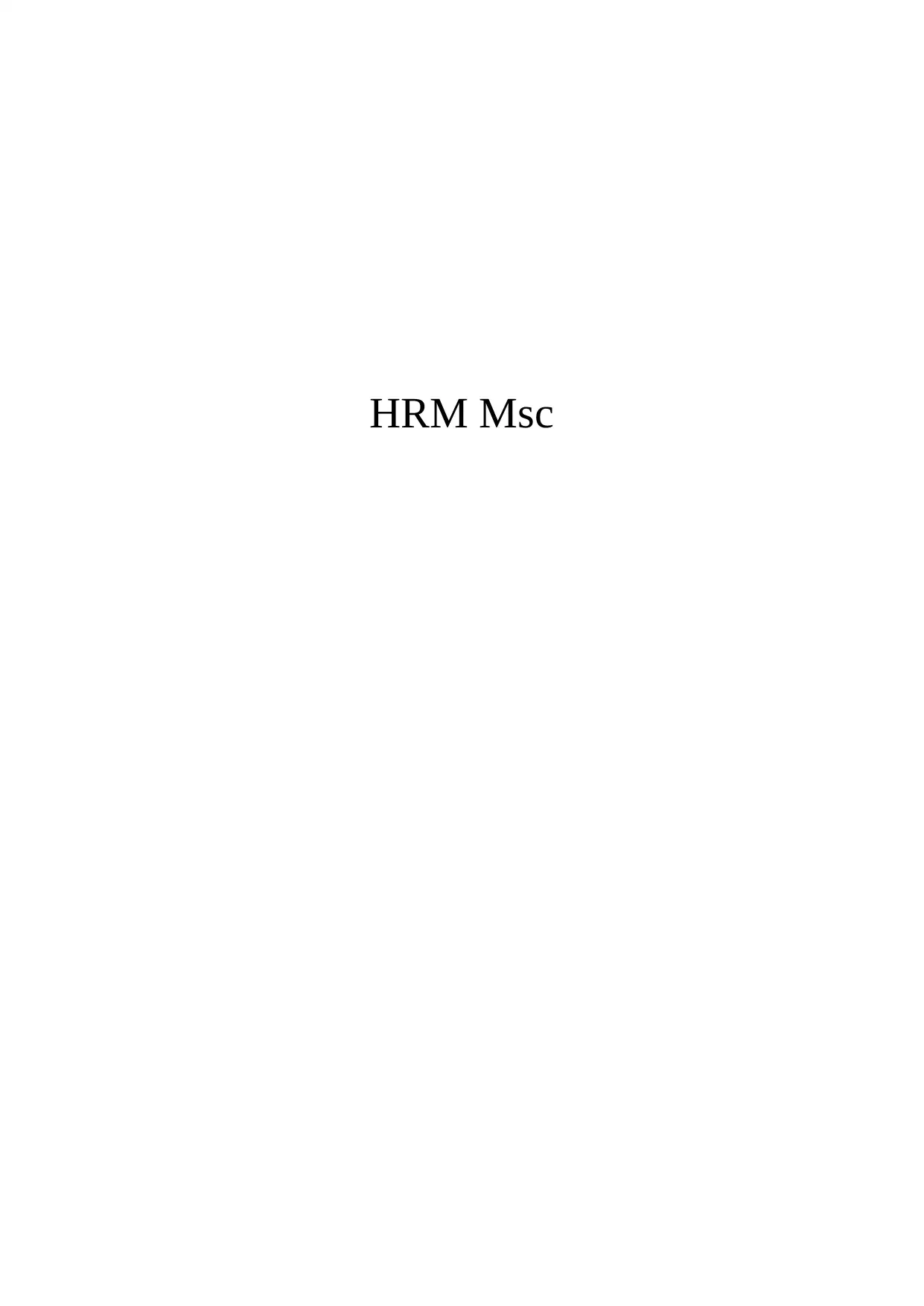
HRM Msc
Paraphrase This Document
Need a fresh take? Get an instant paraphrase of this document with our AI Paraphraser

2
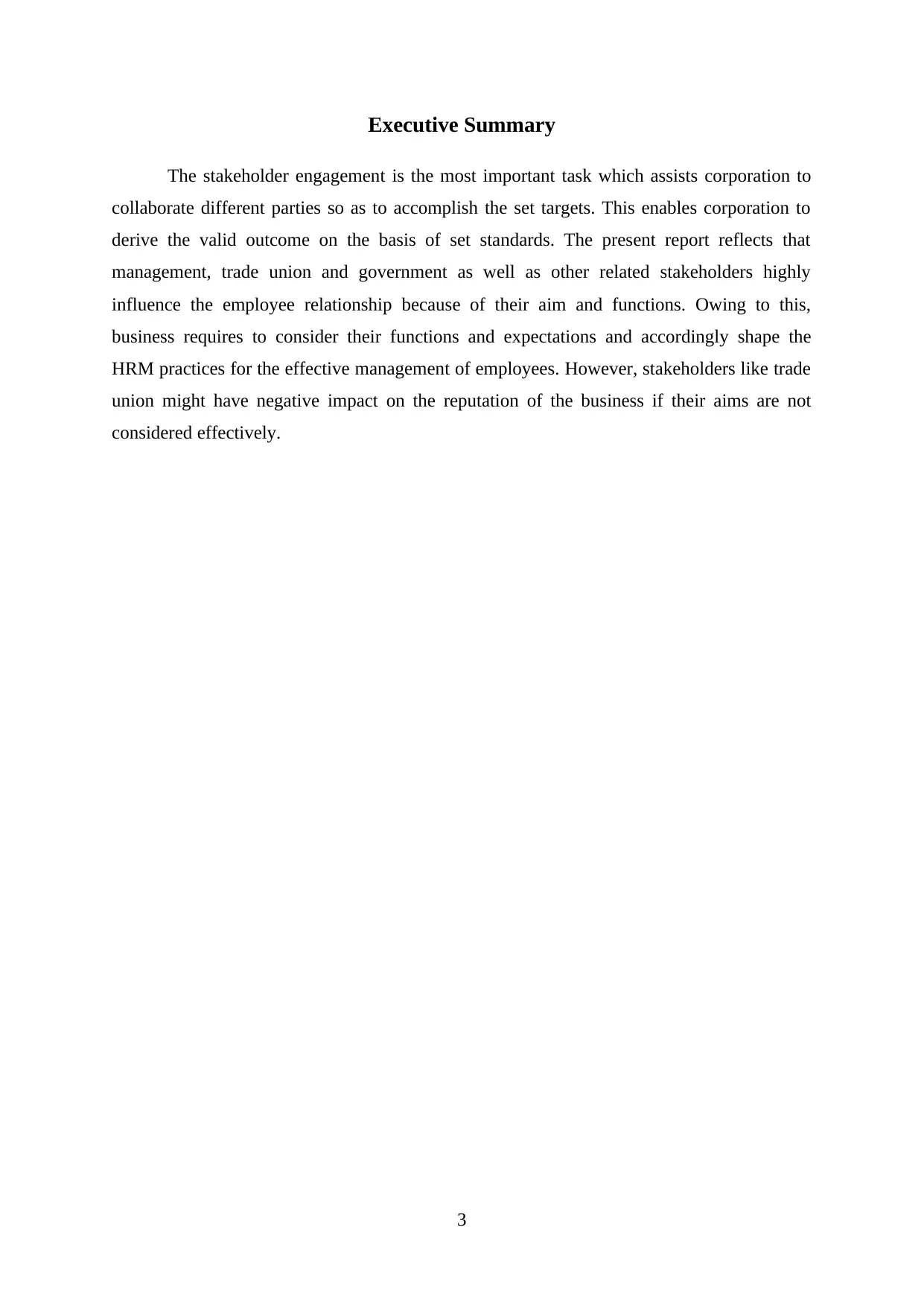
Executive Summary
The stakeholder engagement is the most important task which assists corporation to
collaborate different parties so as to accomplish the set targets. This enables corporation to
derive the valid outcome on the basis of set standards. The present report reflects that
management, trade union and government as well as other related stakeholders highly
influence the employee relationship because of their aim and functions. Owing to this,
business requires to consider their functions and expectations and accordingly shape the
HRM practices for the effective management of employees. However, stakeholders like trade
union might have negative impact on the reputation of the business if their aims are not
considered effectively.
3
The stakeholder engagement is the most important task which assists corporation to
collaborate different parties so as to accomplish the set targets. This enables corporation to
derive the valid outcome on the basis of set standards. The present report reflects that
management, trade union and government as well as other related stakeholders highly
influence the employee relationship because of their aim and functions. Owing to this,
business requires to consider their functions and expectations and accordingly shape the
HRM practices for the effective management of employees. However, stakeholders like trade
union might have negative impact on the reputation of the business if their aims are not
considered effectively.
3
⊘ This is a preview!⊘
Do you want full access?
Subscribe today to unlock all pages.

Trusted by 1+ million students worldwide
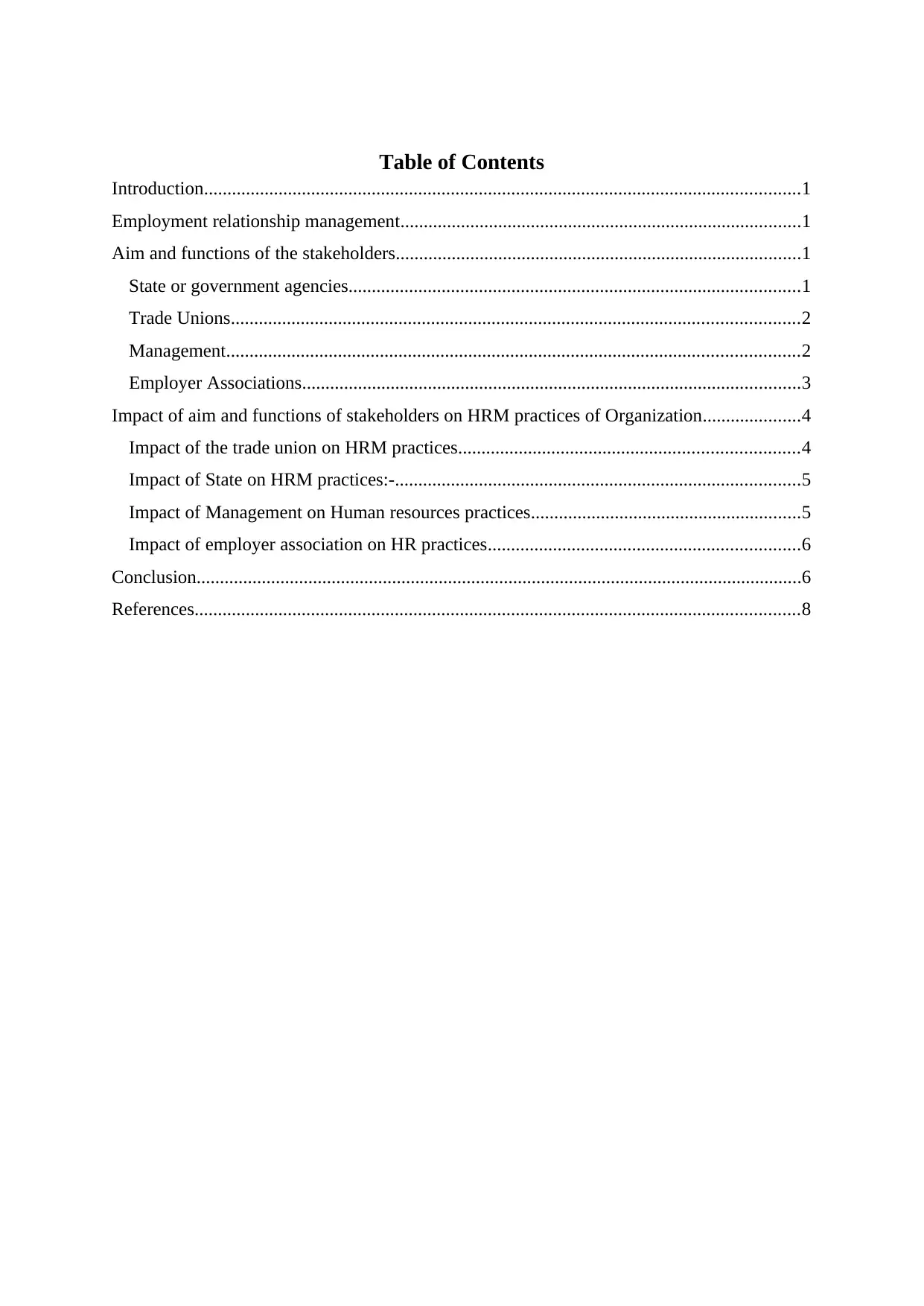
Table of Contents
Introduction................................................................................................................................1
Employment relationship management......................................................................................1
Aim and functions of the stakeholders.......................................................................................1
State or government agencies.................................................................................................1
Trade Unions..........................................................................................................................2
Management...........................................................................................................................2
Employer Associations...........................................................................................................3
Impact of aim and functions of stakeholders on HRM practices of Organization.....................4
Impact of the trade union on HRM practices.........................................................................4
Impact of State on HRM practices:-.......................................................................................5
Impact of Management on Human resources practices..........................................................5
Impact of employer association on HR practices...................................................................6
Conclusion..................................................................................................................................6
References..................................................................................................................................8
Introduction................................................................................................................................1
Employment relationship management......................................................................................1
Aim and functions of the stakeholders.......................................................................................1
State or government agencies.................................................................................................1
Trade Unions..........................................................................................................................2
Management...........................................................................................................................2
Employer Associations...........................................................................................................3
Impact of aim and functions of stakeholders on HRM practices of Organization.....................4
Impact of the trade union on HRM practices.........................................................................4
Impact of State on HRM practices:-.......................................................................................5
Impact of Management on Human resources practices..........................................................5
Impact of employer association on HR practices...................................................................6
Conclusion..................................................................................................................................6
References..................................................................................................................................8
Paraphrase This Document
Need a fresh take? Get an instant paraphrase of this document with our AI Paraphraser
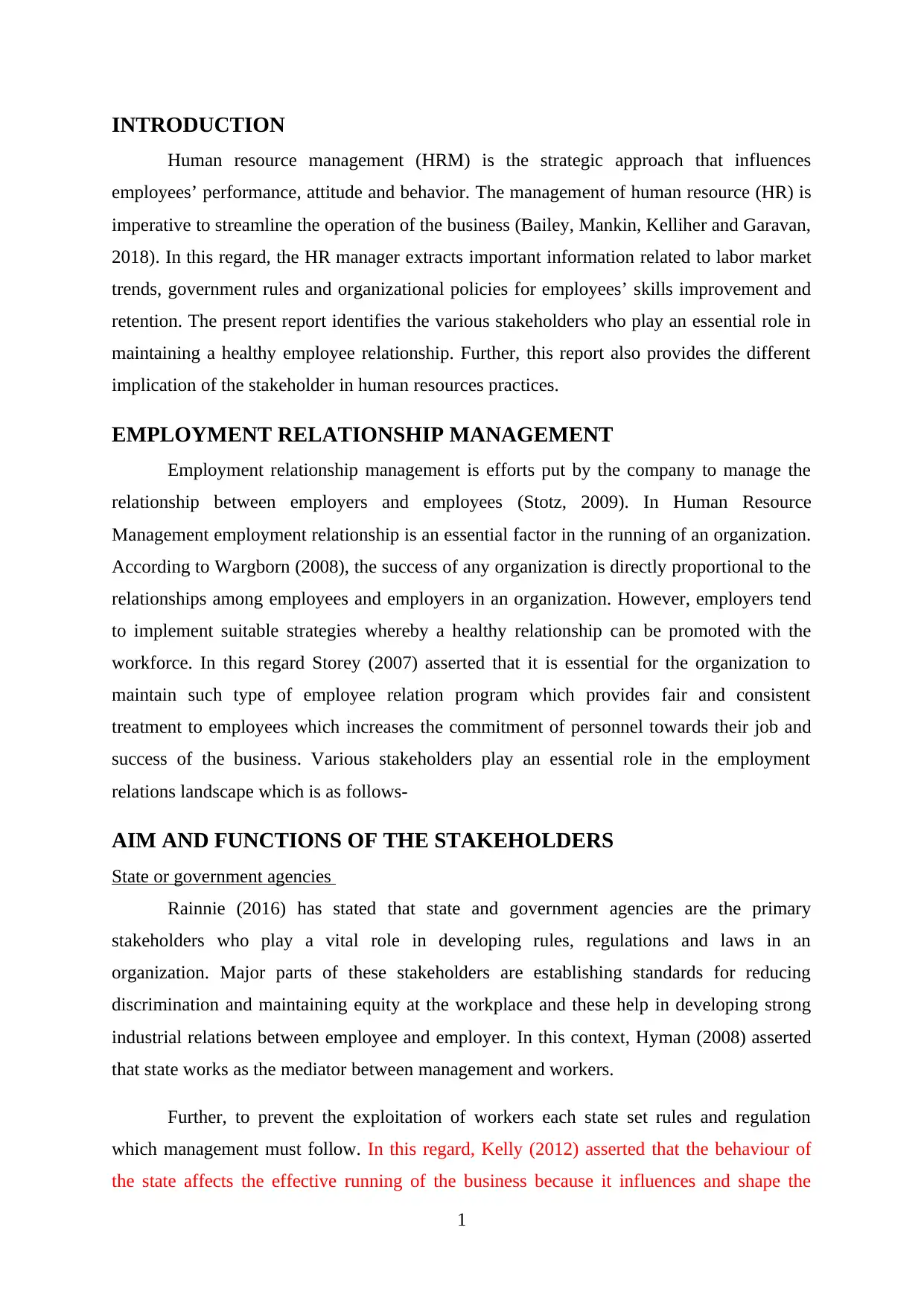
INTRODUCTION
Human resource management (HRM) is the strategic approach that influences
employees’ performance, attitude and behavior. The management of human resource (HR) is
imperative to streamline the operation of the business (Bailey, Mankin, Kelliher and Garavan,
2018). In this regard, the HR manager extracts important information related to labor market
trends, government rules and organizational policies for employees’ skills improvement and
retention. The present report identifies the various stakeholders who play an essential role in
maintaining a healthy employee relationship. Further, this report also provides the different
implication of the stakeholder in human resources practices.
EMPLOYMENT RELATIONSHIP MANAGEMENT
Employment relationship management is efforts put by the company to manage the
relationship between employers and employees (Stotz, 2009). In Human Resource
Management employment relationship is an essential factor in the running of an organization.
According to Wargborn (2008), the success of any organization is directly proportional to the
relationships among employees and employers in an organization. However, employers tend
to implement suitable strategies whereby a healthy relationship can be promoted with the
workforce. In this regard Storey (2007) asserted that it is essential for the organization to
maintain such type of employee relation program which provides fair and consistent
treatment to employees which increases the commitment of personnel towards their job and
success of the business. Various stakeholders play an essential role in the employment
relations landscape which is as follows-
AIM AND FUNCTIONS OF THE STAKEHOLDERS
State or government agencies
Rainnie (2016) has stated that state and government agencies are the primary
stakeholders who play a vital role in developing rules, regulations and laws in an
organization. Major parts of these stakeholders are establishing standards for reducing
discrimination and maintaining equity at the workplace and these help in developing strong
industrial relations between employee and employer. In this context, Hyman (2008) asserted
that state works as the mediator between management and workers.
Further, to prevent the exploitation of workers each state set rules and regulation
which management must follow. In this regard, Kelly (2012) asserted that the behaviour of
the state affects the effective running of the business because it influences and shape the
1
Human resource management (HRM) is the strategic approach that influences
employees’ performance, attitude and behavior. The management of human resource (HR) is
imperative to streamline the operation of the business (Bailey, Mankin, Kelliher and Garavan,
2018). In this regard, the HR manager extracts important information related to labor market
trends, government rules and organizational policies for employees’ skills improvement and
retention. The present report identifies the various stakeholders who play an essential role in
maintaining a healthy employee relationship. Further, this report also provides the different
implication of the stakeholder in human resources practices.
EMPLOYMENT RELATIONSHIP MANAGEMENT
Employment relationship management is efforts put by the company to manage the
relationship between employers and employees (Stotz, 2009). In Human Resource
Management employment relationship is an essential factor in the running of an organization.
According to Wargborn (2008), the success of any organization is directly proportional to the
relationships among employees and employers in an organization. However, employers tend
to implement suitable strategies whereby a healthy relationship can be promoted with the
workforce. In this regard Storey (2007) asserted that it is essential for the organization to
maintain such type of employee relation program which provides fair and consistent
treatment to employees which increases the commitment of personnel towards their job and
success of the business. Various stakeholders play an essential role in the employment
relations landscape which is as follows-
AIM AND FUNCTIONS OF THE STAKEHOLDERS
State or government agencies
Rainnie (2016) has stated that state and government agencies are the primary
stakeholders who play a vital role in developing rules, regulations and laws in an
organization. Major parts of these stakeholders are establishing standards for reducing
discrimination and maintaining equity at the workplace and these help in developing strong
industrial relations between employee and employer. In this context, Hyman (2008) asserted
that state works as the mediator between management and workers.
Further, to prevent the exploitation of workers each state set rules and regulation
which management must follow. In this regard, Kelly (2012) asserted that the behaviour of
the state affects the effective running of the business because it influences and shape the
1
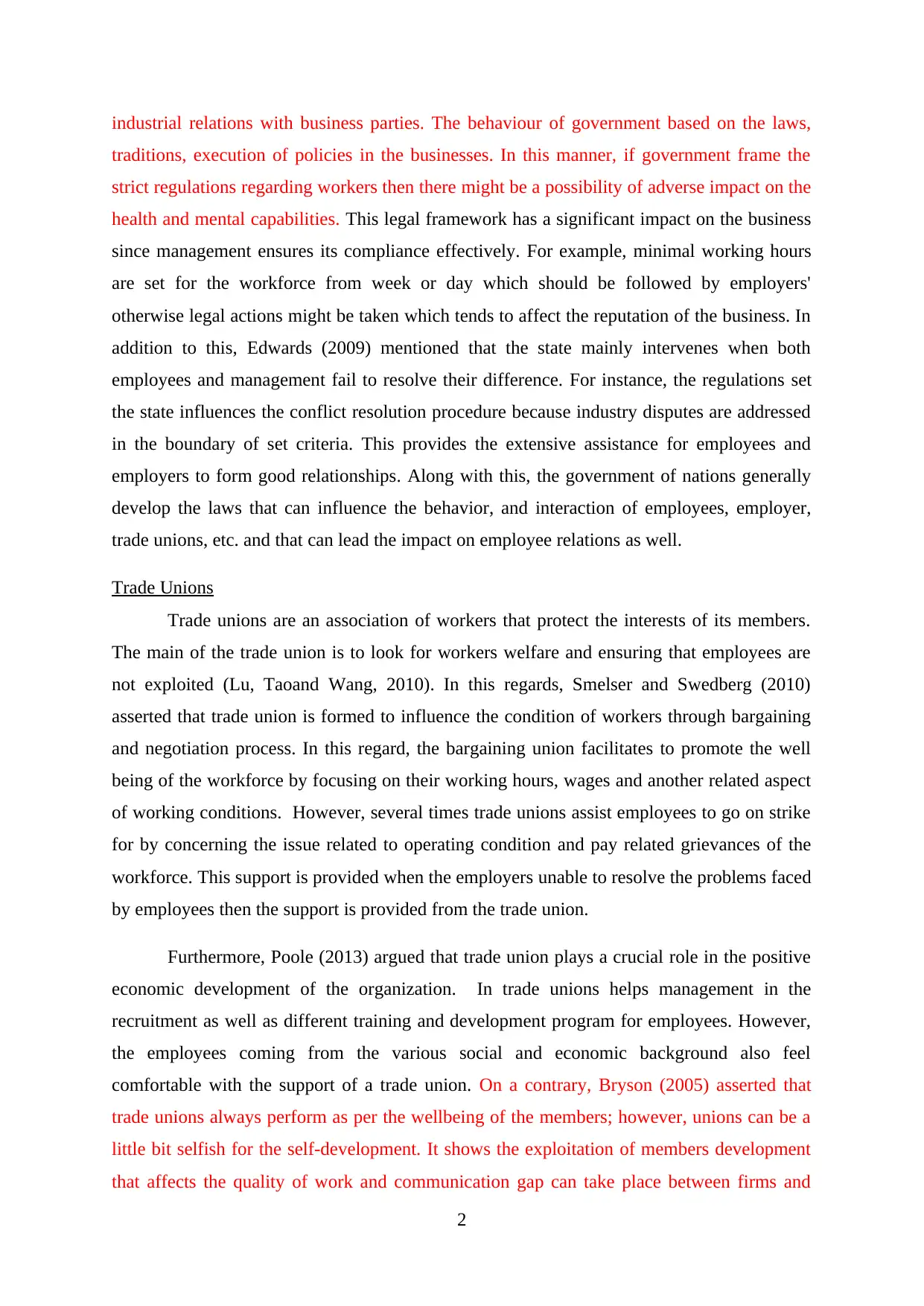
industrial relations with business parties. The behaviour of government based on the laws,
traditions, execution of policies in the businesses. In this manner, if government frame the
strict regulations regarding workers then there might be a possibility of adverse impact on the
health and mental capabilities. This legal framework has a significant impact on the business
since management ensures its compliance effectively. For example, minimal working hours
are set for the workforce from week or day which should be followed by employers'
otherwise legal actions might be taken which tends to affect the reputation of the business. In
addition to this, Edwards (2009) mentioned that the state mainly intervenes when both
employees and management fail to resolve their difference. For instance, the regulations set
the state influences the conflict resolution procedure because industry disputes are addressed
in the boundary of set criteria. This provides the extensive assistance for employees and
employers to form good relationships. Along with this, the government of nations generally
develop the laws that can influence the behavior, and interaction of employees, employer,
trade unions, etc. and that can lead the impact on employee relations as well.
Trade Unions
Trade unions are an association of workers that protect the interests of its members.
The main of the trade union is to look for workers welfare and ensuring that employees are
not exploited (Lu, Taoand Wang, 2010). In this regards, Smelser and Swedberg (2010)
asserted that trade union is formed to influence the condition of workers through bargaining
and negotiation process. In this regard, the bargaining union facilitates to promote the well
being of the workforce by focusing on their working hours, wages and another related aspect
of working conditions. However, several times trade unions assist employees to go on strike
for by concerning the issue related to operating condition and pay related grievances of the
workforce. This support is provided when the employers unable to resolve the problems faced
by employees then the support is provided from the trade union.
Furthermore, Poole (2013) argued that trade union plays a crucial role in the positive
economic development of the organization. In trade unions helps management in the
recruitment as well as different training and development program for employees. However,
the employees coming from the various social and economic background also feel
comfortable with the support of a trade union. On a contrary, Bryson (2005) asserted that
trade unions always perform as per the wellbeing of the members; however, unions can be a
little bit selfish for the self-development. It shows the exploitation of members development
that affects the quality of work and communication gap can take place between firms and
2
traditions, execution of policies in the businesses. In this manner, if government frame the
strict regulations regarding workers then there might be a possibility of adverse impact on the
health and mental capabilities. This legal framework has a significant impact on the business
since management ensures its compliance effectively. For example, minimal working hours
are set for the workforce from week or day which should be followed by employers'
otherwise legal actions might be taken which tends to affect the reputation of the business. In
addition to this, Edwards (2009) mentioned that the state mainly intervenes when both
employees and management fail to resolve their difference. For instance, the regulations set
the state influences the conflict resolution procedure because industry disputes are addressed
in the boundary of set criteria. This provides the extensive assistance for employees and
employers to form good relationships. Along with this, the government of nations generally
develop the laws that can influence the behavior, and interaction of employees, employer,
trade unions, etc. and that can lead the impact on employee relations as well.
Trade Unions
Trade unions are an association of workers that protect the interests of its members.
The main of the trade union is to look for workers welfare and ensuring that employees are
not exploited (Lu, Taoand Wang, 2010). In this regards, Smelser and Swedberg (2010)
asserted that trade union is formed to influence the condition of workers through bargaining
and negotiation process. In this regard, the bargaining union facilitates to promote the well
being of the workforce by focusing on their working hours, wages and another related aspect
of working conditions. However, several times trade unions assist employees to go on strike
for by concerning the issue related to operating condition and pay related grievances of the
workforce. This support is provided when the employers unable to resolve the problems faced
by employees then the support is provided from the trade union.
Furthermore, Poole (2013) argued that trade union plays a crucial role in the positive
economic development of the organization. In trade unions helps management in the
recruitment as well as different training and development program for employees. However,
the employees coming from the various social and economic background also feel
comfortable with the support of a trade union. On a contrary, Bryson (2005) asserted that
trade unions always perform as per the wellbeing of the members; however, unions can be a
little bit selfish for the self-development. It shows the exploitation of members development
that affects the quality of work and communication gap can take place between firms and
2
⊘ This is a preview!⊘
Do you want full access?
Subscribe today to unlock all pages.

Trusted by 1+ million students worldwide

workers. Owing to this, businesses are profoundly affected by the actions and procedures of
the trade union. This enables them to comply with the set standards of union and accordingly
manage the employees as well as a productive relationship with them.
Management
Management is also imperative stakeholder who has a direct impact on the
employment relationship because they perform the task related to compliance of various
policies and procedure set by the government, trade union and state. According to Ngo, Lau
and Foley (2008) management is more concerned about finding the cost-effective ways of
production. In this regard, Management principal aim is to create such type of organizational
culture in which productive and harmonious relationship can be maintained through equal
partnership of management and employees In this context, Rao (2010) asserted that in healthy
employee relationship employee finds their work more exciting and perform their level best
to achieve the company’s goal. For this purpose, managers apply several strategies which
boost the motivation level of the workforce and increase their interest in the job. This leads to
deal with several issues such as high employee turnover, ineffective wage system and useful
working condition. Apart from this, Diehl, Richter and Sarnecki (2016) stated that
uncertainty in management is supportive for the employees to deal with challenges and
maintain a coordination with co-workers to cope up with uncertainty. In order to improve the
competitiveness of the firm, the management provides training and development program
through which employee and employer can interact and work cordially. Furthermore, the
administration also tries to remove the conflicts between the employers and employee to
reduce the wastage of time which affects the firm’s operational efficiency and productivity.
Furthermore, Armstrong and Taylor (2014) stated that the management sets the company
goal and objectives regulated by statutory laws from the state. This regulation reduces the
defects which can be harmful to the company progress.
Employer Associations
Mowday, Porter and Steers (2013) asserted that employer association is a nonprofit
organization that forms to advocate and support employees to get their issues resolved. It
helps in setting the standards for corporation whereby employees are not exploited but
provided comfortable working conditions. In this regard Foster, Punjaisri and Cheng (2010)
stated that employer association ensures that the process of employment relationship benefits
employer with the employee during negotiation with trade union and government
3
the trade union. This enables them to comply with the set standards of union and accordingly
manage the employees as well as a productive relationship with them.
Management
Management is also imperative stakeholder who has a direct impact on the
employment relationship because they perform the task related to compliance of various
policies and procedure set by the government, trade union and state. According to Ngo, Lau
and Foley (2008) management is more concerned about finding the cost-effective ways of
production. In this regard, Management principal aim is to create such type of organizational
culture in which productive and harmonious relationship can be maintained through equal
partnership of management and employees In this context, Rao (2010) asserted that in healthy
employee relationship employee finds their work more exciting and perform their level best
to achieve the company’s goal. For this purpose, managers apply several strategies which
boost the motivation level of the workforce and increase their interest in the job. This leads to
deal with several issues such as high employee turnover, ineffective wage system and useful
working condition. Apart from this, Diehl, Richter and Sarnecki (2016) stated that
uncertainty in management is supportive for the employees to deal with challenges and
maintain a coordination with co-workers to cope up with uncertainty. In order to improve the
competitiveness of the firm, the management provides training and development program
through which employee and employer can interact and work cordially. Furthermore, the
administration also tries to remove the conflicts between the employers and employee to
reduce the wastage of time which affects the firm’s operational efficiency and productivity.
Furthermore, Armstrong and Taylor (2014) stated that the management sets the company
goal and objectives regulated by statutory laws from the state. This regulation reduces the
defects which can be harmful to the company progress.
Employer Associations
Mowday, Porter and Steers (2013) asserted that employer association is a nonprofit
organization that forms to advocate and support employees to get their issues resolved. It
helps in setting the standards for corporation whereby employees are not exploited but
provided comfortable working conditions. In this regard Foster, Punjaisri and Cheng (2010)
stated that employer association ensures that the process of employment relationship benefits
employer with the employee during negotiation with trade union and government
3
Paraphrase This Document
Need a fresh take? Get an instant paraphrase of this document with our AI Paraphraser

intervention. It also saves the employers time by creating two-way communication platform
during the conflict situations in employee and employers.
Furthermore, the interest of the employer association is to defend management
prerogatives against state intervention.
Along with this, it also influences state government on employee relation and trade
issues. Therefore, it is helpful in deriving the valid outcome by fulfilling the demand of
employees and improving the healthy as well as the long-term relationship with the
workforce,
IMPACT OF AIM AND FUNCTIONS OF STAKEHOLDERS ON HRM
PRACTICES OF ORGANIZATION
An employee relation is the one discipline within human resources
that connect with every aspect of employment. There are several human
resources practices such as recruitment and selection, wages,
performance appraisal, employee working condition, training and
development which are influenced by the aim and functions of different
stakeholders.
Impact of the trade union on HRM practices
Trade union influences various human resources practices such as recruitment and
selection, training and development, and wages. In this context, Briscoe, Tarique and Schuler
(2012) stated that trade union plays a diverse role in the recruitment and selection of human
resources practices. According to Bratton, Gold (2017) employers with trade union have the
assurance of a stable and well-trained workforce which reduces the cost of human resource
management. In organizational union design their program to train the workers in their trades.
This reduces the training cost of the inexperienced workers for employers. Further, these
well-trained employees create a better and safer working condition. However, due to
improved working condition work-related injuries and illness would be lesser and employers
get fewer days off from employee side which helps in faster growth of the company.
Another impact of the union is on wages and costing of human resources. In this
context, Armstrong and Taylor (2014) asserted that the union labor contract provides the
employer with the ability to predict future operational cost more accurately for the fixed time
frame. That means union assurance on labors makes more comfortable for the employer to
4
during the conflict situations in employee and employers.
Furthermore, the interest of the employer association is to defend management
prerogatives against state intervention.
Along with this, it also influences state government on employee relation and trade
issues. Therefore, it is helpful in deriving the valid outcome by fulfilling the demand of
employees and improving the healthy as well as the long-term relationship with the
workforce,
IMPACT OF AIM AND FUNCTIONS OF STAKEHOLDERS ON HRM
PRACTICES OF ORGANIZATION
An employee relation is the one discipline within human resources
that connect with every aspect of employment. There are several human
resources practices such as recruitment and selection, wages,
performance appraisal, employee working condition, training and
development which are influenced by the aim and functions of different
stakeholders.
Impact of the trade union on HRM practices
Trade union influences various human resources practices such as recruitment and
selection, training and development, and wages. In this context, Briscoe, Tarique and Schuler
(2012) stated that trade union plays a diverse role in the recruitment and selection of human
resources practices. According to Bratton, Gold (2017) employers with trade union have the
assurance of a stable and well-trained workforce which reduces the cost of human resource
management. In organizational union design their program to train the workers in their trades.
This reduces the training cost of the inexperienced workers for employers. Further, these
well-trained employees create a better and safer working condition. However, due to
improved working condition work-related injuries and illness would be lesser and employers
get fewer days off from employee side which helps in faster growth of the company.
Another impact of the union is on wages and costing of human resources. In this
context, Armstrong and Taylor (2014) asserted that the union labor contract provides the
employer with the ability to predict future operational cost more accurately for the fixed time
frame. That means union assurance on labors makes more comfortable for the employer to
4

control the costs and facilitate to develop new product strategies. Besides, Paauwe (2009)
stated that employee turnover could be reduced with the help of the union. As union gives
assurance to employers that more workers will be available whenever needed. However,
Bamberger, Meshoulam and Biron (2014) argued that when trade union goes on the strike, it
causes the high employee turnover which decreases the productivity and profitable ratio of
management.
Further, in negotiation on the wages and job description union plays a significant role
because it is much easier to communicate with one party rather than each employee. It
reduces the wastage of time and conflict between employers and employees. However,
multiple times due to personal agendas of union leader the influences of the union can go in
the opposite direction. The guidance received from their leader can influence the worker's
behavior and reaction human resources practices. Thus it can vividly impact the human
resource practices (Boxall and Purcell, 2011).
Impact of State on HRM practices:-
The state government implies various rules and saturators regulation which affects
human resources management at both micro and macro levels. According to Noe,
Hollenbeck, Gerhart and Wright (2006) new state legislation and amendments, as well as
tribunal decisions, continue to enhance the impact of the law in the workplace which
influences the human resources practices. In this regard, Kim (2012) stated that State or
government rules and regulations could have a positive impact of setting the wages for
employees. These rules will help in proving the appropriate wages to employees as per their
performance. On the other hand, Holbeche (2009) concluded that it could affect the cost of
the organization because sometimes due to government rules employers’ need to provide high
salary to employees which can increase the total value of the company and that can affect the
employer relations as well.
Furthermore Snell, Morris and Bohlander (2015) mentioned that under the health and
safety regulation, employers are benefitted by various benefits and the absenteeism rate
comparatively reduces which helps to increase the productivity of the company. However,
due to rules, employers need to provide extra training and development programs which
influence the working practices of human resources. Further, under the state law management
need to compensate and offers fringe benefits for the employees because hr practices involve
the use of statutory provisions as a platform through which it can offer the expansion. For
5
stated that employee turnover could be reduced with the help of the union. As union gives
assurance to employers that more workers will be available whenever needed. However,
Bamberger, Meshoulam and Biron (2014) argued that when trade union goes on the strike, it
causes the high employee turnover which decreases the productivity and profitable ratio of
management.
Further, in negotiation on the wages and job description union plays a significant role
because it is much easier to communicate with one party rather than each employee. It
reduces the wastage of time and conflict between employers and employees. However,
multiple times due to personal agendas of union leader the influences of the union can go in
the opposite direction. The guidance received from their leader can influence the worker's
behavior and reaction human resources practices. Thus it can vividly impact the human
resource practices (Boxall and Purcell, 2011).
Impact of State on HRM practices:-
The state government implies various rules and saturators regulation which affects
human resources management at both micro and macro levels. According to Noe,
Hollenbeck, Gerhart and Wright (2006) new state legislation and amendments, as well as
tribunal decisions, continue to enhance the impact of the law in the workplace which
influences the human resources practices. In this regard, Kim (2012) stated that State or
government rules and regulations could have a positive impact of setting the wages for
employees. These rules will help in proving the appropriate wages to employees as per their
performance. On the other hand, Holbeche (2009) concluded that it could affect the cost of
the organization because sometimes due to government rules employers’ need to provide high
salary to employees which can increase the total value of the company and that can affect the
employer relations as well.
Furthermore Snell, Morris and Bohlander (2015) mentioned that under the health and
safety regulation, employers are benefitted by various benefits and the absenteeism rate
comparatively reduces which helps to increase the productivity of the company. However,
due to rules, employers need to provide extra training and development programs which
influence the working practices of human resources. Further, under the state law management
need to compensate and offers fringe benefits for the employees because hr practices involve
the use of statutory provisions as a platform through which it can offer the expansion. For
5
⊘ This is a preview!⊘
Do you want full access?
Subscribe today to unlock all pages.

Trusted by 1+ million students worldwide
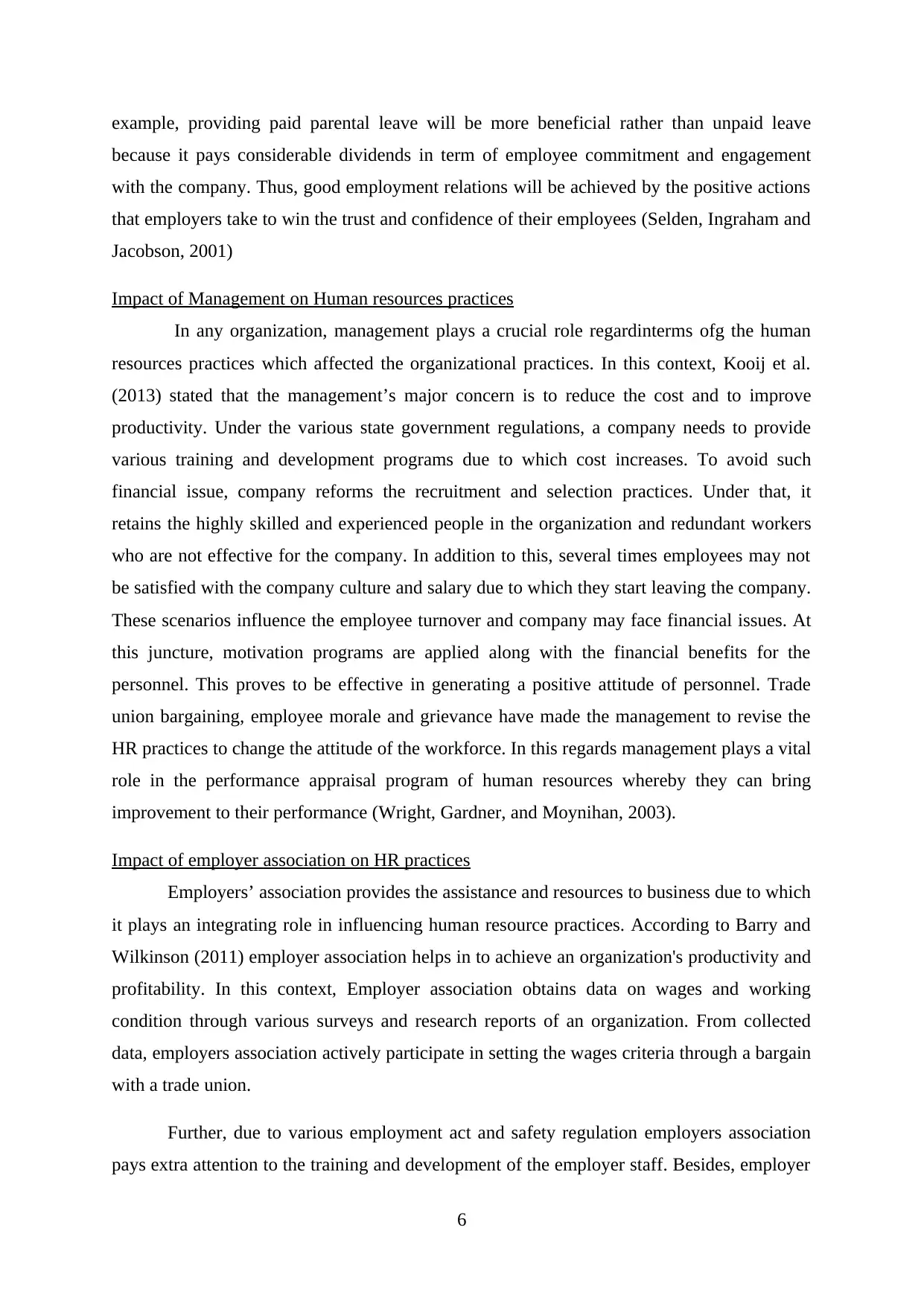
example, providing paid parental leave will be more beneficial rather than unpaid leave
because it pays considerable dividends in term of employee commitment and engagement
with the company. Thus, good employment relations will be achieved by the positive actions
that employers take to win the trust and confidence of their employees (Selden, Ingraham and
Jacobson, 2001)
Impact of Management on Human resources practices
In any organization, management plays a crucial role regardinterms ofg the human
resources practices which affected the organizational practices. In this context, Kooij et al.
(2013) stated that the management’s major concern is to reduce the cost and to improve
productivity. Under the various state government regulations, a company needs to provide
various training and development programs due to which cost increases. To avoid such
financial issue, company reforms the recruitment and selection practices. Under that, it
retains the highly skilled and experienced people in the organization and redundant workers
who are not effective for the company. In addition to this, several times employees may not
be satisfied with the company culture and salary due to which they start leaving the company.
These scenarios influence the employee turnover and company may face financial issues. At
this juncture, motivation programs are applied along with the financial benefits for the
personnel. This proves to be effective in generating a positive attitude of personnel. Trade
union bargaining, employee morale and grievance have made the management to revise the
HR practices to change the attitude of the workforce. In this regards management plays a vital
role in the performance appraisal program of human resources whereby they can bring
improvement to their performance (Wright, Gardner, and Moynihan, 2003).
Impact of employer association on HR practices
Employers’ association provides the assistance and resources to business due to which
it plays an integrating role in influencing human resource practices. According to Barry and
Wilkinson (2011) employer association helps in to achieve an organization's productivity and
profitability. In this context, Employer association obtains data on wages and working
condition through various surveys and research reports of an organization. From collected
data, employers association actively participate in setting the wages criteria through a bargain
with a trade union.
Further, due to various employment act and safety regulation employers association
pays extra attention to the training and development of the employer staff. Besides, employer
6
because it pays considerable dividends in term of employee commitment and engagement
with the company. Thus, good employment relations will be achieved by the positive actions
that employers take to win the trust and confidence of their employees (Selden, Ingraham and
Jacobson, 2001)
Impact of Management on Human resources practices
In any organization, management plays a crucial role regardinterms ofg the human
resources practices which affected the organizational practices. In this context, Kooij et al.
(2013) stated that the management’s major concern is to reduce the cost and to improve
productivity. Under the various state government regulations, a company needs to provide
various training and development programs due to which cost increases. To avoid such
financial issue, company reforms the recruitment and selection practices. Under that, it
retains the highly skilled and experienced people in the organization and redundant workers
who are not effective for the company. In addition to this, several times employees may not
be satisfied with the company culture and salary due to which they start leaving the company.
These scenarios influence the employee turnover and company may face financial issues. At
this juncture, motivation programs are applied along with the financial benefits for the
personnel. This proves to be effective in generating a positive attitude of personnel. Trade
union bargaining, employee morale and grievance have made the management to revise the
HR practices to change the attitude of the workforce. In this regards management plays a vital
role in the performance appraisal program of human resources whereby they can bring
improvement to their performance (Wright, Gardner, and Moynihan, 2003).
Impact of employer association on HR practices
Employers’ association provides the assistance and resources to business due to which
it plays an integrating role in influencing human resource practices. According to Barry and
Wilkinson (2011) employer association helps in to achieve an organization's productivity and
profitability. In this context, Employer association obtains data on wages and working
condition through various surveys and research reports of an organization. From collected
data, employers association actively participate in setting the wages criteria through a bargain
with a trade union.
Further, due to various employment act and safety regulation employers association
pays extra attention to the training and development of the employer staff. Besides, employer
6
Paraphrase This Document
Need a fresh take? Get an instant paraphrase of this document with our AI Paraphraser

association generates the requirement to change the procedure of recruitment and selection
process which can effectively derive the outcome for both business and workforce. Further, it
helps in reducing the recruitment cost by retaining the employees and attracting new
employers (Foster, Punjaisri and Cheng, 2010).
CONCLUSION
The report above concludes that the employment relationship is the most integral part
of any organization success. There are various stakeholders such as trade union, state,
government and employer associations which act in a diverse way to influence the
employment relationships. Further, the report concludes that employee relationships are
based on the relatively more cooperation in which employee and employers both are
motivated to add value in the organization. Also, the report provides these stakeholders’
functions and aim has a significant impact on the different HRM practices of the business.
7
process which can effectively derive the outcome for both business and workforce. Further, it
helps in reducing the recruitment cost by retaining the employees and attracting new
employers (Foster, Punjaisri and Cheng, 2010).
CONCLUSION
The report above concludes that the employment relationship is the most integral part
of any organization success. There are various stakeholders such as trade union, state,
government and employer associations which act in a diverse way to influence the
employment relationships. Further, the report concludes that employee relationships are
based on the relatively more cooperation in which employee and employers both are
motivated to add value in the organization. Also, the report provides these stakeholders’
functions and aim has a significant impact on the different HRM practices of the business.
7
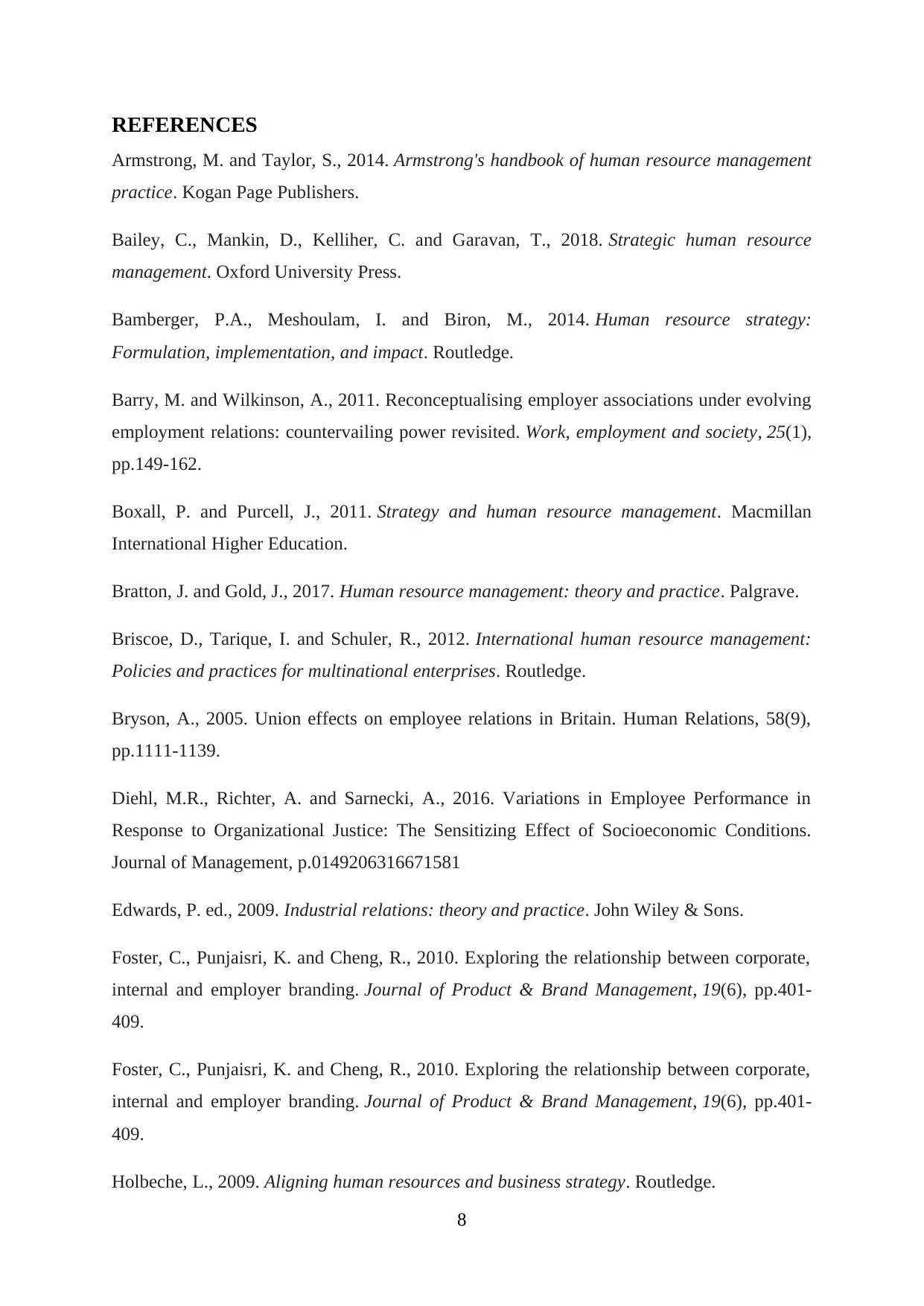
REFERENCES
Armstrong, M. and Taylor, S., 2014. Armstrong's handbook of human resource management
practice. Kogan Page Publishers.
Bailey, C., Mankin, D., Kelliher, C. and Garavan, T., 2018. Strategic human resource
management. Oxford University Press.
Bamberger, P.A., Meshoulam, I. and Biron, M., 2014. Human resource strategy:
Formulation, implementation, and impact. Routledge.
Barry, M. and Wilkinson, A., 2011. Reconceptualising employer associations under evolving
employment relations: countervailing power revisited. Work, employment and society, 25(1),
pp.149-162.
Boxall, P. and Purcell, J., 2011. Strategy and human resource management. Macmillan
International Higher Education.
Bratton, J. and Gold, J., 2017. Human resource management: theory and practice. Palgrave.
Briscoe, D., Tarique, I. and Schuler, R., 2012. International human resource management:
Policies and practices for multinational enterprises. Routledge.
Bryson, A., 2005. Union effects on employee relations in Britain. Human Relations, 58(9),
pp.1111-1139.
Diehl, M.R., Richter, A. and Sarnecki, A., 2016. Variations in Employee Performance in
Response to Organizational Justice: The Sensitizing Effect of Socioeconomic Conditions.
Journal of Management, p.0149206316671581
Edwards, P. ed., 2009. Industrial relations: theory and practice. John Wiley & Sons.
Foster, C., Punjaisri, K. and Cheng, R., 2010. Exploring the relationship between corporate,
internal and employer branding. Journal of Product & Brand Management, 19(6), pp.401-
409.
Foster, C., Punjaisri, K. and Cheng, R., 2010. Exploring the relationship between corporate,
internal and employer branding. Journal of Product & Brand Management, 19(6), pp.401-
409.
Holbeche, L., 2009. Aligning human resources and business strategy. Routledge.
8
Armstrong, M. and Taylor, S., 2014. Armstrong's handbook of human resource management
practice. Kogan Page Publishers.
Bailey, C., Mankin, D., Kelliher, C. and Garavan, T., 2018. Strategic human resource
management. Oxford University Press.
Bamberger, P.A., Meshoulam, I. and Biron, M., 2014. Human resource strategy:
Formulation, implementation, and impact. Routledge.
Barry, M. and Wilkinson, A., 2011. Reconceptualising employer associations under evolving
employment relations: countervailing power revisited. Work, employment and society, 25(1),
pp.149-162.
Boxall, P. and Purcell, J., 2011. Strategy and human resource management. Macmillan
International Higher Education.
Bratton, J. and Gold, J., 2017. Human resource management: theory and practice. Palgrave.
Briscoe, D., Tarique, I. and Schuler, R., 2012. International human resource management:
Policies and practices for multinational enterprises. Routledge.
Bryson, A., 2005. Union effects on employee relations in Britain. Human Relations, 58(9),
pp.1111-1139.
Diehl, M.R., Richter, A. and Sarnecki, A., 2016. Variations in Employee Performance in
Response to Organizational Justice: The Sensitizing Effect of Socioeconomic Conditions.
Journal of Management, p.0149206316671581
Edwards, P. ed., 2009. Industrial relations: theory and practice. John Wiley & Sons.
Foster, C., Punjaisri, K. and Cheng, R., 2010. Exploring the relationship between corporate,
internal and employer branding. Journal of Product & Brand Management, 19(6), pp.401-
409.
Foster, C., Punjaisri, K. and Cheng, R., 2010. Exploring the relationship between corporate,
internal and employer branding. Journal of Product & Brand Management, 19(6), pp.401-
409.
Holbeche, L., 2009. Aligning human resources and business strategy. Routledge.
8
⊘ This is a preview!⊘
Do you want full access?
Subscribe today to unlock all pages.

Trusted by 1+ million students worldwide
1 out of 14
Related Documents
Your All-in-One AI-Powered Toolkit for Academic Success.
+13062052269
info@desklib.com
Available 24*7 on WhatsApp / Email
![[object Object]](/_next/static/media/star-bottom.7253800d.svg)
Unlock your academic potential
Copyright © 2020–2025 A2Z Services. All Rights Reserved. Developed and managed by ZUCOL.





